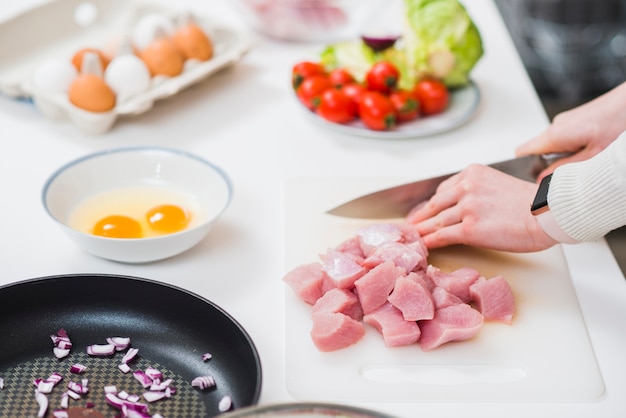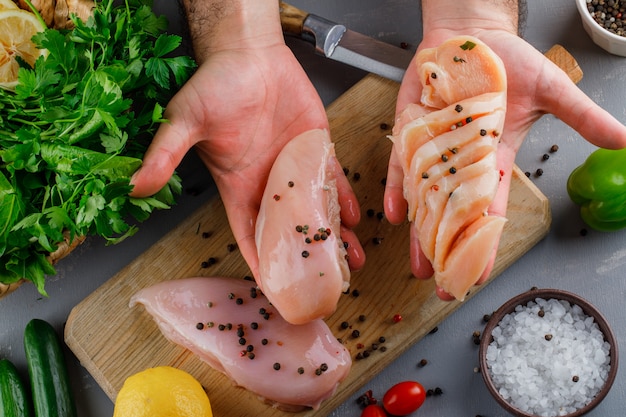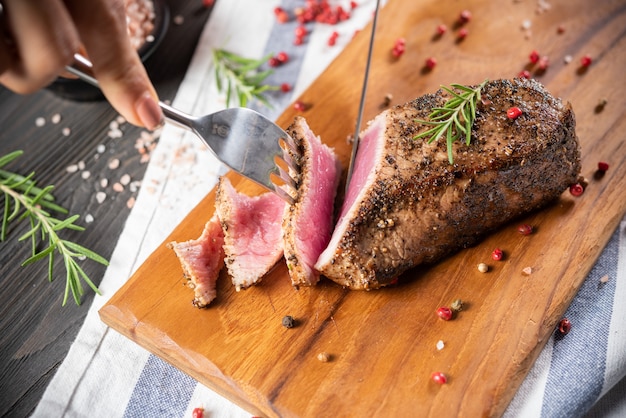Let's face it, pork fillet is a winner. It's the kind of ingredient that makes everyone happy, right? Tender, juicy, and oh-so-versatile, it's perfect for a quick weeknight dinner or a special occasion feast. But, getting it cooked just right can be a bit of a puzzle. You don't want it dry and tough, but you also don't want to risk undercooked pork.
Don't worry, I've got your back. This guide is all about mastering those pork fillet cooking times, from the perfect pan-frying technique to the secrets of succulent roasting. I'll share my own tips and tricks, learned through years of cooking triumphs and a few (admittedly delicious) disasters. So buckle up, because by the end of this, you'll be a pork fillet pro!
(Part 1) Understanding Pork Fillet: A Closer Look

Before we dive into cooking times, let's get acquainted with our star ingredient – the pork fillet. Also known as a tenderloin, it's basically the muscle that runs along the pig's back. This muscle isn't particularly active, making it naturally tender and lean – hence its popularity for quick cooking methods.
Choosing the Right Pork Fillet: Finding a Winner
When you're at the butcher or supermarket, look for a fillet that's a lovely, even pale pink color. It should feel firm to the touch and have a good amount of fat marbling running through it. This marbling adds flavor and keeps the fillet moist during cooking. Don't be shy, ask the butcher for advice – they're the experts!
Getting to Know Your Fillet: Size Matters
Pork fillets come in a variety of sizes. A small fillet might be perfect for a romantic dinner for two, while a larger one will feed a hungry family. Don't be afraid to ask the butcher to trim it to the size you need. This way, you'll avoid ending up with too much leftover pork (although, delicious leftovers are always a bonus!).
Storing Your Fillet: Keep It Fresh
It's essential to store your pork fillet correctly to ensure it stays fresh and flavorful. Here's the lowdown:
Refrigerate: Store your uncooked pork fillet in the refrigerator in an airtight container or wrapped tightly in plastic wrap. It's best to use it within 3-5 days.
Freezing: If you need to store it for longer, you can freeze it. Wrap the fillet tightly in plastic wrap and then place it in a freezer bag. Frozen pork fillet can last up to 3 months in the freezer.
(Part 2) Pork Fillet Cooking Times: A Guide to Perfect Results

Now, let's get to the heart of the matter – cooking times. This is where the magic happens, but it can also be a bit tricky. But don't worry, with a few simple tips, you'll be nailing those pork fillet cooking times in no time.
The Importance of Temperature: Safety First
The key to perfectly cooked pork fillet is to ensure it reaches an internal temperature of 145°F (63°C). This is the safe temperature that ensures the pork is fully cooked without being overdone. overcooked pork can be dry and tough, so aiming for this temperature is crucial.
The Right Tools: A meat thermometer is Your Friend
A meat thermometer is your best friend when it comes to cooking pork fillet. It's the only way to ensure you're reaching that crucial 145°F (63°C) internal temperature. There are various types of meat thermometers available, but a digital one with a quick reading is the most convenient.
Cooking Times: A Starting Point
Remember, these are just guidelines. Your actual cooking time might vary depending on the size and thickness of your fillet. The good news is, a meat thermometer will take all the guesswork out of it.
| Cooking Method | Time (minutes) |
|---|---|
| Pan-frying | 4-6 per side (medium) |
| Baking | 20-25 minutes (medium) |
| Roasting | 30-40 minutes (medium) |
Resting Time: Let It Rest, It's Crucial
Once your pork fillet is cooked, let it rest for a few minutes before slicing and serving. This allows the juices to redistribute throughout the meat, resulting in a more tender and juicy piece of pork.
(Part 3) Pan-Frying Pork Fillet: The Quick and Easy Way

Pan-frying is my go-to method for weeknight meals. It's quick, simple, and you can achieve a beautiful, crispy crust. Here's how to do it right:
1. The Pre-Game: Setting the Stage
Get Your Pan Hot: Use a heavy-bottomed pan, like a cast iron skillet, and let it heat up on medium-high heat. You want it good and sizzling before you add the fillet.
Season Generously: Season your fillet generously with salt and pepper. Don't be shy! You can also add other spices like paprika, cumin, or garlic powder. Experiment and find what you love.
Avoid Overcrowding: Don't cram too many fillets in the pan. This will lower the temperature and prevent a good sear. Cook in batches if necessary.
2. The Action Begins: Searing and Cooking
Sear the Fillets: Place your fillets in the hot pan and cook for about 4-6 minutes per side, or until they develop a beautiful golden-brown crust. Be careful not to overcook them at this stage.
Reduce the Heat: Once they're browned, reduce the heat to low and continue cooking for another 3-5 minutes, or until the internal temperature reaches 145°F (63°C).
3. The Finish: Resting and Serving
Let It Rest: Once the fillets are cooked, take them off the heat and let them rest for a few minutes before slicing and serving. This allows the juices to redistribute, making for a more succulent and flavorful piece of pork.
(Part 4) Baking Pork Fillet: Easy and Delicious
Baking is another great option for pork fillet. It's less hands-on than pan-frying, and you can create a beautiful, crispy crust in the oven.
1. Prep It Right: Get Ready to Bake
Preheat Your Oven: Set your oven to 375°F (190°C). Give it time to reach the right temperature before you start cooking.
Prepare Your Pan: Use a roasting pan or a baking dish. You can line it with parchment paper to make cleanup easier.
Season and Stuff (Optional): Season the fillet generously with salt, pepper, and any other spices you like. You can also stuff it with herbs, garlic, or a flavorful filling for extra flavor.
2. Bake It to Perfection: Golden Brown Goodness
Bake the Fillet: Place the seasoned fillet in the prepared pan and bake for 20-25 minutes, or until the internal temperature reaches 145°F (63°C).
Check for Doneness: Use a meat thermometer to check the internal temperature. If the fillet is still not cooked through, bake it for a few more minutes, checking every few minutes.
3. Let It Rest: The Key to Tenderness
Rest the Fillet: Once the fillet is cooked, remove it from the oven and let it rest for 5-10 minutes before slicing and serving. This lets the juices redistribute, leading to a more tender and juicy result.
(Part 5) roasting pork Fillet: Elevate Your Dinner
For a more special occasion, roasting your pork fillet takes it to a whole new level. It's a bit more involved than pan-frying or baking, but the results are worth the effort.
1. The Roasting Prep: Get Your Oven Ready
Preheat Your Oven: Set your oven to 400°F (200°C). Give it time to reach the right temperature for a consistent roast.
Season and Tie: Season the fillet generously with salt and pepper. You can also add other spices, herbs, or a marinade to enhance the flavor. If the fillet is large, consider tying it with kitchen twine to hold its shape.
Choose Your Roasting Pan: Use a roasting pan with a rack to prevent the fillet from sitting in its juices and becoming soggy.
Add Vegetables (Optional): roast vegetables alongside the fillet for a delicious and easy meal.
2. roasting time: Cook It Low and Slow
Roast the Fillet: Place the seasoned fillet on the rack in the roasting pan and roast for 30-40 minutes, or until the internal temperature reaches 145°F (63°C).
Basting: Basting the fillet with its juices or a flavorful marinade during the roasting process can help create a more flavorful and succulent result.
3. Rest and Serve: The Finishing Touches
Rest the Fillet: Once the fillet is cooked, remove it from the oven and let it rest for 10-15 minutes before slicing and serving. This helps the juices redistribute and makes the fillet more tender.
(Part 6) Pork Fillet Variations: A World of Flavor
Pork fillet is incredibly versatile. You can pair it with different flavors and create a whole new range of dishes. Let's explore some exciting variations:
1. Herbed and Garlic Fillet: A Classic Combination
For a simple yet flavorful dish, try rubbing the fillet with a mixture of chopped garlic, rosemary, thyme, and olive oil. This adds a fragrant and savory flavor that's perfect for a comforting meal.
2. Honey-Glazed Fillet: Sweet and Savory Perfection
For a sweet and savory twist, glaze the fillet with a mixture of honey, soy sauce, and ginger. This creates a sticky and delicious glaze that complements the pork beautifully.
3. Apricot and Almond Fillet: Sophisticated and Delicious
For a more sophisticated flavor, try a combination of dried apricots, toasted almonds, and a touch of orange zest. This creates a sweet and savory flavor profile that's both unique and delicious.
4. Spicy Pork Fillet: Add Some Heat
If you like things a bit spicier, try adding some chili flakes, cayenne pepper, or a touch of sriracha to your marinade. Experiment with different spice levels to find what you enjoy best.
5. Citrusy Pork Fillet: Bright and Refreshing
A citrusy marinade adds a bright and refreshing twist to pork fillet. Combine lemon juice, orange zest, and fresh herbs for a tangy and flavorful marinade.
(Part 7) Pork Fillet Sides: Perfect Pairings
No pork fillet is complete without some delicious sides. Here are a few ideas that pair beautifully with the tender, juicy meat:
1. Roasted Vegetables: A Classic Combination
Roasted root vegetables like carrots, potatoes, and parsnips are classic accompaniments for pork fillet. They provide a sweet and earthy counterpoint to the richness of the pork.
2. Green Salad: A Refreshing Contrast
A crisp green salad with a light vinaigrette adds a refreshing contrast to the rich flavors of the pork. It's a perfect way to balance the meal.
3. mashed potatoes: A Comforting Classic
creamy mashed potatoes are a comfort food classic and a perfect partner for roasted or baked pork fillet. They add a comforting and satisfying touch to the meal.
4. rice pilaf: A Touch of Elegance
A simple rice pilaf with aromatic herbs and vegetables adds a touch of elegance to any pork fillet meal. It's a beautiful way to elevate your dinner.
5. sweet potato Fries: A Delicious Twist
sweet potato fries add a touch of sweetness and a satisfying crunch to your pork fillet meal. They're a fun and flavorful alternative to traditional potato fries.
(Part 8) Leftovers: Making the Most of Your Pork Fillet
Got leftover pork fillet? Don't worry, you can use it to create delicious new dishes. Here are some ideas:
1. Pork Salad: A Light and Refreshing Meal
Dice the leftover pork and toss it with a green salad, cherry tomatoes, and a tangy dressing for a light and refreshing meal.
2. Pork Stir-Fry: A Quick and Easy Dinner
Slice the leftover pork and stir-fry it with your favorite vegetables and sauce for a quick and easy dinner.
3. Pork Sandwiches: A Satisfying Lunch or Dinner
Slice the leftover pork and serve it in sandwiches with your favorite toppings for a satisfying lunch or dinner.
4. Pork Quesadillas: Delicious and Easy
Slice the leftover pork and add it to a quesadilla with cheese, salsa, and sour cream for a delicious and easy meal.
5. Pork fried rice: A Flavorful and Filling Meal
Dice the leftover pork and add it to a pan of fried rice with your favorite vegetables and soy sauce for a flavorful and filling meal.
(Part 9) FAQs: Answers to Your Questions
1. What Happens If I Overcook Pork Fillet?
Overcooked pork fillet will be dry and tough, and it won't be as flavorful. The best way to avoid overcooking is to use a meat thermometer and cook it to an internal temperature of 145°F (63°C).
2. Can I Cook Pork Fillet From Frozen?
It’s not recommended to cook pork fillet from frozen. Frozen pork can take longer to cook and may not cook evenly. It’s best to thaw the fillet in the refrigerator overnight before cooking.
3. What's the Best Way to Store Leftover Pork Fillet?
Leftover pork fillet should be stored in the refrigerator in an airtight container. It can last up to 3-4 days.
4. Can I Reheat Leftover Pork Fillet?
Yes, you can reheat leftover pork fillet. You can reheat it in the oven, microwave, or skillet.
5. What Are Some Good Marinades for Pork Fillet?
There are many great marinades for pork fillet. Some popular choices include soy sauce, honey, garlic, ginger, lemon juice, and olive oil. Experiment with different combinations to find your favorite.
Remember, cooking pork fillet is an art, and there are always new things to learn and try. Have fun with it, experiment, and most importantly, enjoy the delicious results!
Everyone is watching

How to Cook Frozen Lobster Tails Perfectly: A Step-by-Step Guide
RecipesLobster. Just the word conjures up images of lavish meals, special occasions, and a taste of luxury. But let's...

Pigs in a Blanket Cooking Time: How Long to Bake for Perfect Results
RecipesAh, pigs in a blanket. Just the name conjures up images of those delightful little parcels of crispy pastry en...

Pork Fillet Cooking Time: How Long to Cook It Perfectly
RecipesPork fillet, or tenderloin as it's sometimes called, is a real favourite in our house. It's so versatile, and...

The Ultimate Guide to Cooking Delicious Frankfurters
RecipesLet's face it, we all love a good frankfurter. It's a classic, simple, and always satisfying. But let's be rea...

Wolf Meat Recipes: A Guide to Cooking Wild Game
RecipesLet's be honest, you don't see wolf meat at your local butcher shop every day. It's a bit of a wild card, but ...
